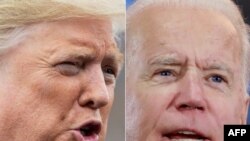ບັນດາຜູ້ມີສິດປ່ອນບັດແມ່ນພວມເລືອກເອົາປະທານາທິບໍດີດໍໂນລ ທຣຳ ແລະຄູ່ແຂ່ງຈາກພັກເດໂມແຄຣັດອະດີດຮອງປະທານາທິບໍດີໂຈ ໄບເດັນໃນການເລືອກ ຕັ້ງປະທານາທິບໍດີຂອງສະຫະລັດ ບໍ່ຄວນທີ່ຈະມີບັນຫາຫຍຸ້ງຍາກໃດໆ ໃນການໄຈ້ແຍກບຸກຄົນທັງສອງ ກ່ຽວກັບຄຳຖາມໃນເລື້ອງນະໂຍບາຍ.
ຄວາມແຕກຕ່າງ ກ່ຽວກັບທ່າທີ ຂອງຜູ້ສະໝັກທັງສອງ ຢູ່ໃນບັນຫາຕ່າງໆ ກໍມີເລື້ອງດິນຟ້າອາກາດ ການເກັບພາສີ ການຄ້າ ຄວາມສຳພັນດ້ານເຊື້ອຊາດຜິວພັນ ຄວາມໝັ້ນຄົງແຫ່ງຊາດ ຄົນເຂົ້າເມືອງແລະສຳຄັນກວ່າໝູ່ໝົດກໍແມ່ນເລື້ອງການຮັບມືກັບໄວຣັສໂຄໂຣນາ ແມ່ນເຫັນໄດ້ຢ່າງຊັດແຈ້ງ ແລະກໍສະໜອງໃຫ້ຜູ້ມີສິດປ່ອນບັດ ດ້ວຍທາງເລືອກທີ່ແຕກຕ່າງກັນ ສຳລັບທິດທາງຂອງປະເທດໃນໄລຍະ 4 ປີຕໍ່ໜ້າ.
ໂດຍທົ່ວໄປແລ້ວ ປະທານາທິບໍດີດໍໂນລ ທຣຳແມ່ນເປັນຜູ້ຄວບຄຸມ ດັ່ງທີ່ທ່ານໄດ້ໂຄສະນາຫາສຽງເມື່ອ 4 ປີກ່ອນ ໃນຖານະສະມາຊິກພັກຣີພັບບລີກັນຜູ້ທີ່ບໍ່ເຮັດຕາມຫຼັກການທີ່ເຄີຍປະຕິບັດກັນມາ ໂດຍໄດ້ກຳນົດເສັ້ນທາງຂອງຕົນເອງ. ນັ້ນແມ່ນເປັນຄວາມຈິງ ທັງໃນດ້ານຄວາມສຳພັນກັບປະເທດອື່ນໆ ບ່ອນທີ່ປລັດຊະຍາ “ອາເມຣິກາມາກ່ອນ” ຂອງທ່ານ ໄດ້ທົດສອບຄວາມສຳພັນຂອງສະຫະລັດກັບບັນດາພັນທະມິດມາເປັນເວລາດົນນານ ແລະໃນດ້ານການເມືອງພາຍໃນປະເທດ ບ່ອນທີ່ທ່ານໄດ້ຊຸກຍູ້ຢ່າງສະໝ່ຳສະເໝີຕໍ່ຂອບເຂດອຳນາດຝ່າຍບໍລິຫານ ຊຶ່ງມັກຈະເຮັດໃຫ້ທ່ານຖືກຢຸດໂດຍຝ່າຍຕຸລາການຂອງລັດຖະບານກາງ.
ທ່ານໄບເດັນ ໃນທາງກົງກັນຂ້າມ ແມ່ນໄດ້ໂຄສະນາຫາສຽງຊຶ່ງສ່ວນໃຫຍ່ແມ່ນພາຍໃຕ້ນະໂຍບາຍຫົວກ້າວໜ້າ ປະສົມປະສານກັບການເອົາທ່າທີດ້ວຍການໃຫ້ຄຳໝັ້ນສັນຍາວ່າ ທ່ານຈະນຳເອົາປະເທດຊາດກັບຄືນໄປສູ່ຮູບແບບການເມືອງທີ່ເຄີຍເຮັດກັນມາ ຊຶ່ງຈະມີການເພັ່ງເລັງໜ້ອຍລົງຕໍ່ການສົ່ງທະວີດເຕີ້ແລະການໂຮມຊຸມນຸມຂອງປະຊາຊົນ ແລະມີການອະພິປາຍກ່ຽວກັບລາຍລະອຽດຂອງນະໂຍບາຍຫຼາຍຂຶ້ນກວ່າເກົ່າ ແລະການຕໍ່ລອງກັນກ່ຽວກັບເລື້ອງຮ່າງກົດໝາຍ.
ໃນຂະນະທີ່ມີຊາວອາເມຣິກັນເສຍຊີວິດແລ້ວ ຫຼາຍກວ່າ 225,000 ຄົນ ຍ້ອນໂຣກລະບາດໄວຣັສໂຄໂຣນາ ແລະກໍລະນີຕິດເຊື້ອໃໝ່ໃນທຸກໆມື້ ໃນລະດັບທີ່ສູງສຸດແບບບໍ່ເຄີຍມີມາກ່ອນຢູ່ນີ້ ມັນຈຶ່ງເປັນທີ່ຈະແຈ້ງກ່ຽວກັບແຜນການຮັບມືກັບເຊື້ອໄວຣັສດັ່ງກ່າວຂອງລັດຖາບານທ່ານທຣຳສ່ວນໃຫຍ່ແລ້ວແມ່ນຂຶ້ນຢູ່ກັບການພັດທະນາຢາວັກຊີນແລະການປິ່ນປົວພວກທີ່ຕິດພະຍາດ ແທນທີ່ຈະແມ່ນການສຸມຄວາມພະຍາຍາມໃສ່ ເພື່ອໃຫ້ອັດຕາການແຜ່ລະບາດຊ້າລົງ.
ໃນວັນອາທິດທີ່ຜ່ານມານີ້ ຫົວໜ້າທີ່ປຶກສາຂອງທຳນຽບຂາວ ທ່ານມາກ ແມໂດສ໌ (Mark Meadows) ໄດ້ກ່າວຢ່າງຈະແຈ້ງວ່າ ລັດຖະບານສະຫະລັດບໍ່ເຊື່ອວ່າຕົນສາມາດ “ຄວບຄຸມ” ເຊື້ອໄວຣັສ. ທັງລັດຖະບານ ແລະປະທານາທິບໍດີເອງບໍ່ໄດ້ໃຫ້ຄວາມສຳຄັນໃນເລື້ອງໃສ່ໜ້າກາກຊຶ່ງພວກນັກຊ່ຽວຊານດ້ານສຸຂະພາບກ່າວວ່າ ຈະຫລຸດອັດຕາການຕິດເຊື້ອລົງແລະຊ່ວຍຊີວິດຜູ້ຄົນໄດ້ຢ່າງຫຼວງຫຼາຍ.
Voters choosing between President Donald Trump and former Democratic Vice President Joe Biden in the U.S. presidential election should have no difficulty distinguishing between the two men on policy questions.
The differences in the candidates’ positions on a large variety of issues -- climate, taxes, trade, race relations, national security, immigration, and above all the handling of the coronavirus pandemic -- are stark and provide voters with two very distinct options for the direction of the country over the coming four years.
In general, President Trump has governed as he campaigned four years ago, as a norm-busting Republican iconoclast who forges his own path. That’s true both in his relationship with other nations, where his “America First” philosophy has tested the bonds between the U.S. and long-time allies, and in domestic politics, where he has consistently pushed the boundaries of executive authority, frequently finding himself reined in by the federal judiciary.
Biden, by contrast, has campaigned on a combination of largely progressive policy positions coupled with a promise that he will return the nation to a more traditional form of politics -- one less focused on Twitter and mass rallies and more on detailed policy debates and legislative deal making.
Coronavirus response
With more than 225,000 Americans dead in the coronavirus pandemic and daily new cases at the highest level ever, it has become clear that the Trump administration’s plan for dealing with the virus hinges mainly on the development of vaccines and therapeutic treatments for those infected, rather than a concerted effort to slow transmission rates.
On Sunday, White House Chief of Staff Mark Meadows explicitly said that the administration does not believe it can “control” the virus. The administration, and the president himself, have downplayed the importance of wearing masks, which public health experts say would sharply reduce infection rates and save lives.
Biden supports the development of vaccines and therapeutic treatments, but at the same time advocates for a more active federal approach to containment of the virus. Biden has repeatedly said that he believes a nationwide mask mandate is both legal and necessary.
Both Trump and Biden support the reopening of schools, but where Biden proposes providing federal funding to help schools open safely, Trump has proposed withholding federal money from schools that fail to reopen.





